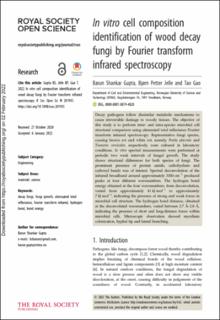| dc.contributor.author | Gupta, Barun Shankar | |
| dc.contributor.author | Jelle, Bjørn Petter | |
| dc.contributor.author | Gao, Tao | |
| dc.date.accessioned | 2022-02-04T11:33:00Z | |
| dc.date.available | 2022-02-04T11:33:00Z | |
| dc.date.created | 2022-01-27T17:26:46Z | |
| dc.date.issued | 2022 | |
| dc.identifier.citation | Royal Society Open Science. 2022, 9 1-15. | en_US |
| dc.identifier.issn | 2054-5703 | |
| dc.identifier.uri | https://hdl.handle.net/11250/2977152 | |
| dc.description.abstract | Decay pathogens follow dissimilar metabolic mechanisms to cause irreversible damage to woody tissues. The objective of this study is to perform inter- and intra-species microbial cell structural comparison using attenuated total reflectance Fourier transform infrared spectroscopy. Representative fungi species, causing brown rot and white rot, namely, Postia placenta and Trametes versicolor, respectively, were cultured in laboratory conditions. In vitro spectral measurements were performed at periodic two week intervals of fungal growth. The study shows structural differences for both species of fungi. The prominent presence of protein amide, carbohydrate and carboxyl bands was of interest. Spectral deconvolution of the infrared broadband around approximately 3300 cm−1 produced peaks at four different wavenumbers. The hydrogen bond energy obtained at the four wavenumbers, from deconvolution, varied from approximately 41 kJ mol−1 to approximately 7 kJ mol−1, indicating the presence of strong and weak forces in microbial cell structure. The hydrogen bond distance, obtained at the deconvoluted wavenumbers, varied between 2.7 Å–2.8 Å, indicating the presence of short and long-distance forces within microbial cells. Microscopic observation showed mycelium colonization, hyphal tip and lateral branching. | en_US |
| dc.language.iso | eng | en_US |
| dc.publisher | The Royal Society | en_US |
| dc.rights | Navngivelse 4.0 Internasjonal | * |
| dc.rights.uri | http://creativecommons.org/licenses/by/4.0/deed.no | * |
| dc.title | In Vitro Cell Composition Identification of Wood Decay Fungi by Fourier Transform Infrared Spectroscopy | en_US |
| dc.type | Peer reviewed | en_US |
| dc.type | Journal article | en_US |
| dc.description.version | publishedVersion | en_US |
| dc.source.pagenumber | 1-15 | en_US |
| dc.source.volume | 9 | en_US |
| dc.source.journal | Royal Society Open Science | en_US |
| dc.identifier.doi | https://doi.org/10.1098/rsos.201935 | |
| dc.identifier.cristin | 1991712 | |
| cristin.ispublished | true | |
| cristin.fulltext | original | |
| cristin.qualitycode | 1 | |

